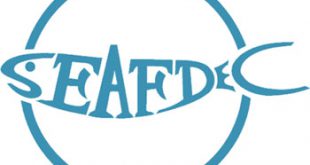Trial runs at SEAFDEC/AQD’s Igang Marine Station (Guimaras, west central Philippines) have verified the technology for growing the tropical abalone Haliotis asinina to cocktail size in just six months.
The tropical abalone is one of the fastest, if not the fastest-growing farmed abalone in the world. From an initial size of 26-30 mm shell length (SL) and average body weight (ABW) of 4-6 g, it can reach the saleable cocktail size (50 mm SL, ABW = 30 g ) in 180 days of culture. “This is an average monthly growth rate of at least 3.4 mm and 4.1 g per month,” noted AQD’s abalone grow-out specialist Mr. Vincent Encena II.
To grow abalone the AQD way, the abalone is stocked in prefabricated, multi-tier plastic trays specifically designed for its culture at stocking densities of 50 to 100 pcs per m2. It is fed seaweed Gracilaria every three days. The culture period is 180 days, the survival rate is high at 85%, and the feed conversion ratio is 18.5.
H. asinina spawns or breeds twice a month the whole year, and for abalone growers, this means juveniles are available each month for stocking. “Theoretically,” Mr. Encena said, “it is possible to harvest abalone every month after an initial growing period of six months by using a modular system, that is, by a monthly cycle of stocking juveniles and harvesting cocktail-sized abalone.”
The Philippines exported an average of 440 tons of abalone [worth Php 114 million or USD 2.35 M] each year from 1990 to 2005. Recent exports however, show a severe decline from an all-time high of 633 tons in 2004, to an all-time low of 218 tons in 2008. “This is most probably due to overfishing and habitat degradation,” Mr. Encena said. “Abalone aquaculture, then, has the potential of significantly increasing the country’s export earnings.”
International abalone symposium
Mr. Encena had the opportunity to present results of his study at the 8th International abalone symposium that was held in Hobart, Tasmania, Australia from 6 to 11 May 2012. His paper on “Nursery and grow-out of the tropical abalone Haliotis asinina Linne 1758” was co-authored with Ms. Milagros de la Peña and Mr. Vicente Balinas.
AQD scientist Dr. Myrna Teruel also attended the same symposium and presented her paper on “Evaluation of agar-bound microparticulate diet as alternative food in abalone hatchery: effects of agar concentrations and feeding frequencies.” She co-authored this with Ms. de la Peña and Ms. Analyn Asutilla.
Noted Dr. Teruel about the symposium: “It was a multi-disciplinary event combining aspects of abalone fisheries, biology, economics and trade, with 150 oral and poster presentations. Prominent ‘abalone people’ in attendance included Dr. Peter Britz, Dr. Nick Elliot and Dr. Peter Cook, among others.”
There were also workshops on biosecurity and re-seeding (resource enhancement); the latter is of much interest to AQD, being one of the regional programs funded by GOJ-TF (Government of Japan Trust Fund).”
International training on abalone at AQD
AQD conducted its regular training on “Abalone hatchery and grow-out” from 10 to 30 May at its main station in Iloilo. Funded by GOJ-TF, it had seven participants from private and government institutions in Cambodia, Vietnam and Philippines. The course is also the second one conducted by AQD this year; the first, on “Abalone culture technology” was held 20-24 February for five fisherfolk from Sagay City (Philippines), also funded by GOJ-TF.



 SEAFDEC/AQD Southeast Asian Fisheries Development Center | Aquaculture Department
SEAFDEC/AQD Southeast Asian Fisheries Development Center | Aquaculture Department
